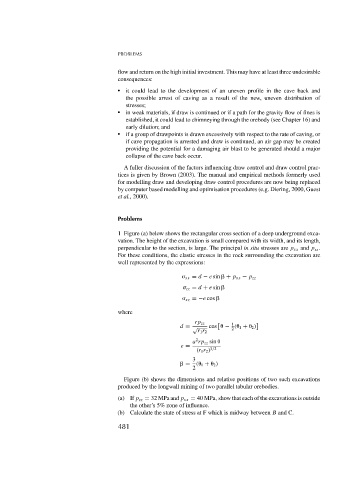Page 499 - Rock Mechanics For Underground Mining
P. 499
PROBLEMS
flow and return on the high initial investment. This may have at least three undesirable
consequences:
it could lead to the development of an uneven profile in the cave back and
the possible arrest of caving as a result of the new, uneven distribution of
stresses;
in weak materials, if draw is continued or if a path for the gravity flow of fines is
established, it could lead to chimneying through the orebody (see Chapter 16) and
early dilution; and
if a group of drawpoints is drawn excessively with respect to the rate of caving, or
if cave propagation is arrested and draw is continued, an air gap may be created
providing the potential for a damaging air blast to be generated should a major
collapse of the cave back occur.
A fuller discussion of the factors influencing draw control and draw control prac-
tices is given by Brown (2003). The manual and empirical methods formerly used
for modelling draw and developing draw control procedures are now being replaced
by computer based modelling and optimisation procedures (e.g. Diering, 2000, Guest
et al., 2000).
Problems
1 Figure (a) below shows the rectangular cross section of a deep underground exca-
vation. The height of the excavation is small compared with its width, and its length,
perpendicular to the section, is large. The principal in situ stresses are p xx and p zz .
For these conditions, the elastic stresses in the rock surrounding the excavation are
well represented by the expressions:
xx = d − e sin + p xx − p zz
zz = d + e sin
xz =−e cos
where
rp zz 1
d = √ cos
− (
1 +
2 )
2
r 1 r 2
2
a rp zz sin
e =
(r 1 r 2 ) 3/2
3
= (
1 +
2 )
2
Figure (b) shows the dimensions and relative positions of two such excavations
produced by the longwall mining of two parallel tabular orebodies.
(a) If p zz = 32 MPa and p xx = 40 MPa, show that each of the excavations is outside
the other’s 5% zone of influence.
(b) Calculate the state of stress at F which is midway between B and C.
481

